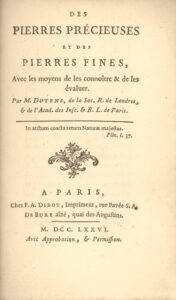Paris, F. A. Didot, de Bure aîné, 1776.
In-16, (1) l., xii pp., (1) l., 124 pp., (2) ll. Green jansenist morocco, ribbed spine, double gilt fillet on edges, gilt edges over marbling, spine slightly lightened. Bound by Hardy.
130 x 78 mm.
Rare first edition of this highly sought-after gemmological treatise.
Jammes, Les Didot, no. 73; Brunet, II, 922; Conlon 76:952 (= BL, NUC); Sinkankas 1817 (“not seen”), cp. 1819.
Very attractive, this first edition is very rare. John Sinkankas, author of Gemology, an annotated bibliography, has never even seen it.
Dutens drew on his personal experience, his visits to Europe’s major gemstone collections and the work of his colleagues to propose the most complete and accurate nomenclature of rare and precious stones of his time.
He also deals with the size and weight of diamonds, rubies and emeralds, deception in jewelry, agathas and aquamarines….
The first part describes “precious” stones (diamond, ruby, emerald, garnet…), the second “fine” stones (agate, onyx, carnelian, opal…).
In the end, we find a report on a diamond calcination experiment and an interesting price table for cut diamonds from 1 to 30 carats, which served as a reference for many years.
François-Ambroise Didot’s typography was particularly successful, prompting Mérard de Saint-Just to say: “This little treatise is the first work to come off the presses of M. Didot l’aîné, in which we have seen that superiority of talent which immediately set him above all his colleagues in France, Italy, Germany and Holland, and which from then on associated him with the glory of Baskerville, and above all with that of Ibarra”.
Very popular in its day, Dutens’ treatise was reprinted in 1777, 1778 and 1783, and translated into German in 1779.
Philologist, numismatist and historiographer to the King of Great Britain, Louis Dutens (1730-1812) was born in Tours of Calvinist parents. He left France for London, where his uncle was a jeweler, joined the Anglican clergy and became a diplomat in Turin, then tutor to the son of the Duke of Northumberland.
A very fine copy in Hardy’s Jansenist binding.
Provenance: ex-libris de Saint-Geniès



